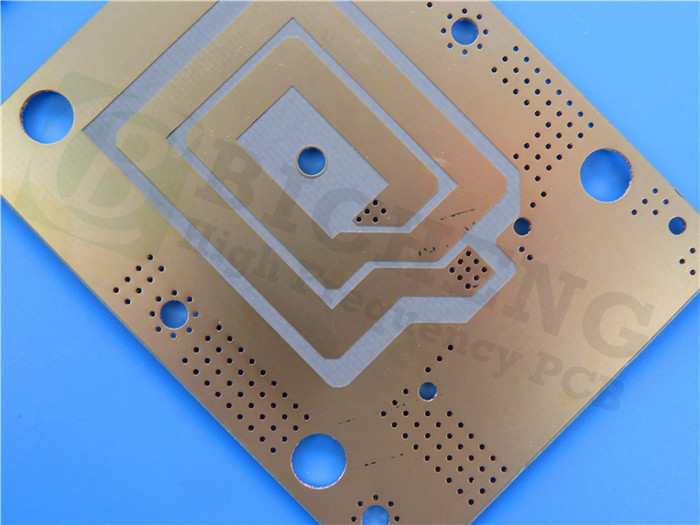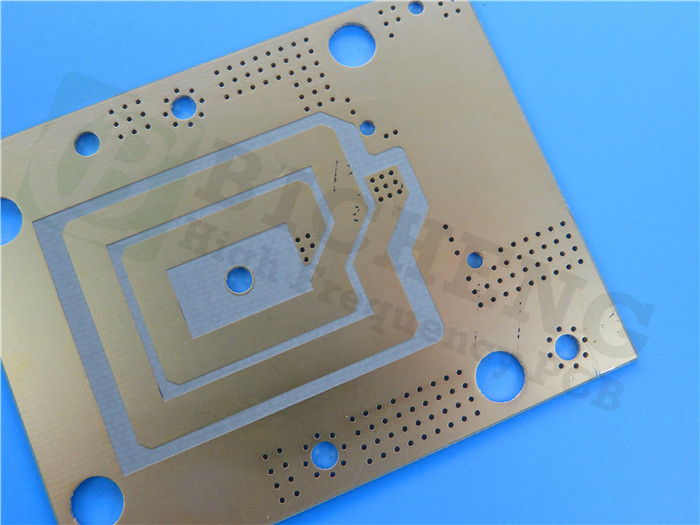In the ever-evolving world of high-frequency electronics, the demand for superior circuit board performance has never been more crucial. As technology advances, engineers and designers are faced with the challenge of achieving higher data rates, lower signal loss, and improved system efficiency. This is where the
Rogers DiClad 880 PCB shines, offering a unique blend of material properties that make it an exceptional choice for a wide range of high-frequency applications.
Introduction
The DiClad 880 30mil material is a woven fiberglass-reinforced, PTFE-based composite laminate developed by the renowned Rogers Corporation. By carefully balancing the ratio of woven fiberglass and PTFE, the DiClad 880 achieves a lower dielectric constant (Dk) and dissipation factor (Df) compared to other laminates in the DiClad series. This innovative design allows for the construction of printed circuit boards (PCBs) that can support higher frequencies while maintaining exceptional signal integrity and low power loss.

Features and Benefits of DiClad 880 PCBs
The DiClad 880 30mil substrate PCB boasts an impressive array of features that make it a standout choice for high-frequency applications:
1.Low Dielectric Constant (Dk):
The DiClad 880 has a Dk of 2.17 or 2.2 ± 0.04 at 10 GHz/23°C and 1 MHz. This low Dk value is crucial for maintaining low insertion loss and supporting wider trace widths, which are essential for improving signal integrity and reducing electromagnetic interference (EMI).
2.Low Dissipation Factor (Df):
The DiClad 880 has an exceptionally low Df of 0.0009 at 10 GHz/23°C and 0.0008 at 1 MHz, ensuring minimal energy loss and efficient signal transmission.
3.Stable Dielectric Properties:
The DiClad 880 boasts a low temperature coefficient of dielectric constant (TcDk) of -160 ppm/°C, ranging from -10°C to 140°C. This stability ensures consistent performance across a wide temperature range, making it suitable for a variety of environmental conditions.
4.Exceptional Moisture Resistance:
With the lowest moisture absorption (0.02%) among PTFE-based composites, the DiClad 880 is highly resistant to environmental factors, ensuring long-term reliability and performance.
5.Tailored Coefficient of Thermal Expansion (CTE):
The DiClad 880 has a CTE of 25 ppm/°C in the X-axis, 34 ppm/°C in the Y-axis, and 252 ppm/°C in the Z-axis. This unique CTE profile helps to mitigate thermal stress and ensure dimensional stability, preventing issues such as warping or delamination.
6.Broad Frequency Range:
The DiClad 880's stable Dk over a wide frequency range allows for its use in a variety of high-frequency applications, from radar and phased array networks to digital radio antennas and filters.
PCB Construction and Specifications
The DiClad 880 high frequency PCB featured in this blog is a 2-layer rigid board with the following construction details:
Board Dimensions: 60 mm x 60 mm, with a tolerance of ±0.15 mm
Copper Layer Thickness: 35 μm (1 oz) on both outer layers
Dielectric Thickness: 0.762 mm (30 mil)
Minimum Trace/Space: 5/5 mils
Minimum Hole Size: 0.35 mm
Finished Board Thickness: 0.8 mm
Via Plating Thickness: 20 μm
Surface Finish: Immersion Silver
Electrical Testing: 100% tested prior to shipment
This specific PCB configuration is designed to meet the requirements of IPC-Class-2 standards, ensuring reliable performance and consistency across multiple units.

Typical Applications for DiClad 880 PCBs
The exceptional material properties of the DiClad 880 make it an ideal choice for a wide range of high-frequency applications, including:
Radar Feed Networks:
The low Dk and Df of the DiClad 880 make it an excellent substrate for radar feed networks, supporting efficient signal transmission and minimizing power loss.
Commercial Phased Array Networks:
The stable dielectric properties and tailored CTE of the DiClad 880 make it well-suited for the construction of phased array antennas used in commercial communication systems.
Low-Loss Base Station Antennas:
The DiClad 880's low-loss characteristics contribute to the development of highly efficient base station antennas, improving overall system performance.
Guidance Systems:
The DiClad 880's reliable performance and environmental resilience make it a suitable choice for guidance systems, such as those found in aerospace and defense applications.
Digital Radio Antennas:
The DiClad 880's broad frequency range and low-loss properties allow for the design of high-performance digital radio antennas, supporting the transmission of data-intensive signals.
Filters, Couplers, and Low-Noise Amplifiers (LNAs):
The DiClad 880's exceptional dielectric properties make it an excellent substrate for the construction of high-frequency filters, couplers, and LNAs, ensuring optimal signal integrity and efficiency.
Conclusion
The Rogers DiClad 880 PCB is a remarkable solution for engineers and designers seeking to push the boundaries of high-frequency electronics. With its low dielectric constant, low dissipation factor, and exceptional material properties, the DiClad 880 Printed Circuit Board enables the construction of high-performance printed circuit boards that can handle the demands of today's and tomorrow's cutting-edge applications. Whether you're working on radar systems, phased array networks, or digital radio antennas, the DiClad 880 is a technology that can unlock new levels of efficiency, reliability, and signal integrity.

 Call Us Now !
Tel : +86 755 27374946
Call Us Now !
Tel : +86 755 27374946
 Order Online Now !
Email : info@bichengpcb.com
Order Online Now !
Email : info@bichengpcb.com















